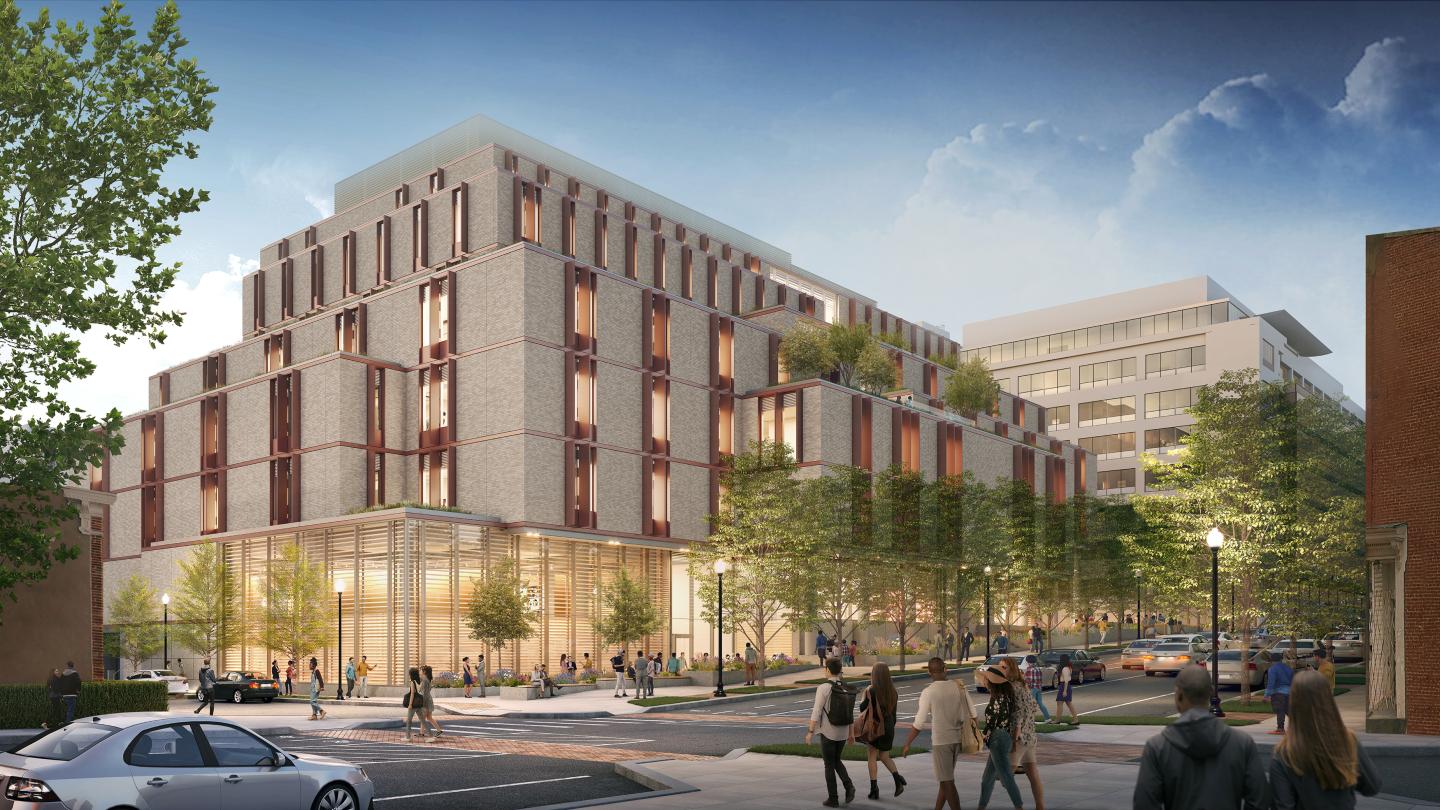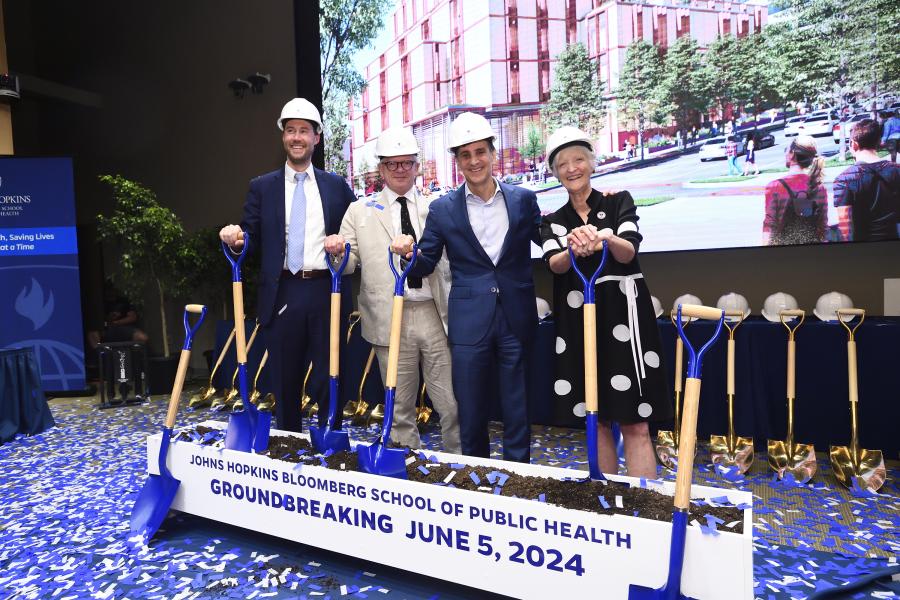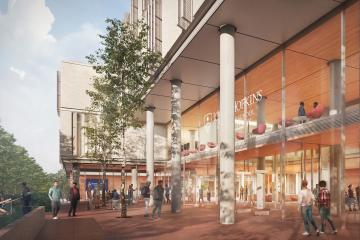A rapidly aging population, staggering rates of heart disease and diabetes, a new family of coronavirus variants, natural disasters fueled by climate change.
The list of challenges faced by public health experts and practitioners goes on, so much so that the mood at the June 5 groundbreaking ceremony for the Johns Hopkins Bloomberg School of Public Health's new South Building was festive while also focused on the work that lies ahead. For the Bloomberg School's leadership, faculty, staff, students, and supporters in attendance, the evening offered a chance to reflect on the evolving nature of public health—and how the new building will help them keep doing what they do best: protecting health and saving lives, millions at a time.
The new building will be situated at the corner of McElderry and Washington streets, adjacent to the Bloomberg School's existing buildings on North Wolfe Street and North Broadway in the heart of the university's East Baltimore campus. With approximately 250,000 gross square feet across seven floors, the building will support the school's mission to inspire and educate the next generation of public health leaders through dynamic workspaces, state-of-the-art classrooms, and a variety of spaces for study, collaboration, and events, including gatherings with community groups.

Image credit: Hamish Jackson / Hopkins Architects
"Today's public health challenges are so complex," Bloomberg School Dean Ellen J. MacKenzie told the crowd gathered in Sommer Hall for the event. "Whether we are working on the problems of opioid overdose, gun violence, the growing mental health crisis, or threats to our environment, we need innovative thinking, long-range strategies—and very importantly, strong partnerships. That means we need a space designed around the values of community and collaboration, because it's only through community and collaboration that we can meet the challenges ahead."
The Bloomberg School of Public Health is the largest public health institution in the world, with 10 academic departments, more than 1,500 faculty members, 80-plus research centers, and more than 3,200 students from 93 nations. Yet it currently resides in a labyrinth-like collection of classrooms, laboratories, hallways, and stairwells that can leave faculty, staff, and students feeling disconnected. In the new building, expected to be completed in late 2026, departments will become "neighborhoods" with informal gathering spaces that flow from one to another, encouraging "interdisciplinary partnerships [and] serendipitous conversations that lead to new ideas," MacKenzie said.
Likewise, the first floor will welcome community members and become the home base for SOURCE, the community engagement and service-learning center for the schools of Public Health, Nursing, and Medicine, which collaborates with more than 100 community-based organizations in Baltimore.
"Yes, we're celebrating the transformative potential of the many facets of the building itself," JHU President Ron Daniels said during the groundbreaking ceremony. "... But we're also celebrating something greater than the sum of these individual elements, and that is the power of the proximity of people and ideas that this building will unleash as all members of the Bloomberg School come together under one single roof."
Video credit: Johns Hopkins Bloomberg School of Public Health
Daniels acknowledged the difficulty of saying goodbye to the Hampton House Building at 624 N. Broadway, the former home of three academic departments that will move into the new building. Hampton House will be leveled as part of a broader East Baltimore campus transformation. Yet the new building will open doors of opportunity, Daniels added, creating more space for the Bloomberg School's growing enrollment and faculty—and "an inherent magic" made possible by scientists, social scientists, doctors, nurses, and other practitioners working together to "translate discovery into concrete policy reform," he said.
London-based Hopkins Architects, which designed the South Building, will work in partnership with Baltimore-based Hord Coplan Macht Inc. as architect of record to build a facility that will meet the demands of public health education, research, and practice well into the future.
"From our earliest sketches, we have sought to create an architecture that will offer a new identity for the School of Public Health … that reaches out into the broader context of the city," said Andrew Barnett, principal at Hopkins Architects. "At street level, we've created a series of welcoming and accessible spaces that will promote engagement with the community and link from an entry plaza to a central forum to a landscaped courtyard at the very heart [of the design] to bring new opportunities for interdisciplinary encounters and collaboration."
Inspired by the principles of transparency, connectivity, and sustainability, the building's flexible layout will feature media production broadcast and podcast studios, plus smart classrooms outfitted with hybrid learning technology to facilitate connections with colleagues from around the world. The design will also add much-needed green space to the East Baltimore campus, including an expansion of the existing School of Nursing courtyard that will provide a shared collegial space between the two schools. In keeping with Johns Hopkins' dedication to minimizing the university's environmental footprint, the South Building will integrate energy-efficient features and is targeting a LEED Gold Rating.
MacKenzie, Daniels, Barnett, and J.D. Merrill, Baltimore's interim deputy mayor for equity, health, and human services, donned hard hats and picked up shovels to partake in the symbolic groundbreaking, though the event was moved indoors due to the threat of inclement weather. MacKenzie noted that the last time the school broke ground on a new building was more than a century ago—the school was founded in 1916 and later opened its doors to only a handful of students at 615 N. Wolfe Street in 1926.
"As we look to our next era of public health work, the Bloomberg School is committed to partnering even more closely with local communities and to deepening our collaborative efforts toward the shared vision of a healthier world," she said. "Ultimately, that's what today's all about."
Posted in University News
Tagged university construction









